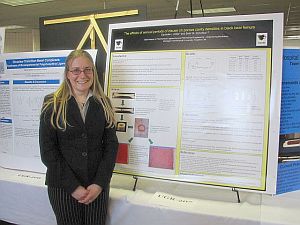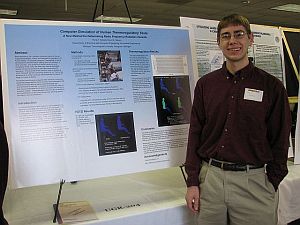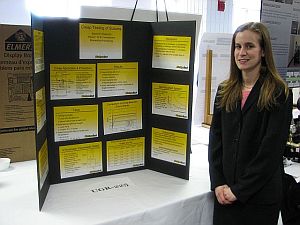1st
Place Award Undergraduate Research Presentation

Student Researcher: Danielle Miller
Project Title: The effects of annual periods of disuse on porous
cavity densities in black bear femurs
Advisors: Seth Donahue, Biomedical Engineering
Abstract: Osteoporosis is a condition characterized
by decreased bone density and increased porosity, causing reduced
bone strength and increased fracture risk. In addition to the well-known
age-induced condition, osteoporosis can occur as a result of reduced
mechanical stresses on bone (i.e., disuse). Black bears experience
disuse (hibernation) for approximately 6 months out of the year
each year, but they do not suffer the adverse effects of skeletal
unloading on bone mechanical properties.
The
mechanisms behind this phenomenon are still unknown, yet it is likely
that bears have a unique biological process that helps them maintain
balanced bone remodeling during hibernation. By analyzing the porosity
of black bear femurs, this study attempted to offer insight into
the phenomenon of maintained bone strength in black bears despite
annual hibernation. Since black bears maintain formation during
hibernation and have elevated bone formation post hibernation it
was hypothesized that porosity would not change with age despite
annual periods of disuse with limited recovery time.
The
femurs analyzed were obtained from 27 hunter-killed bears ranging
in age from 2 to 20 years. Slides were prepared from the midshaft
of the bone and were analyzed using semi-automated image analysis
software. Porosity was defined as total porous area divided by the
total cortical area (%). Total porosity did not significantly change
with age in males or females. Interestingly, the males had a significantly
higher porosity than females even though female bears give birth
and nurse cubs every other year; this is contrary to what is seen
in humans and other animals. Therefore, this study provides further
evidence that black bears have a unique ability to resist the effects
of disuse osteoporosis, such as increased porosity, and thus can
prevent increased fracture risk.

Student Researcher: Hans Nyberg
Project Title: Computer Simulation of Human Thermoregulatory Tests
Advisors: David Nelson Biomedical Engineering
Sponsor: ThermoAnalytics, Inc. and MTU Office of Educational Opportunity
Abstract: Thermoregulatory tests on human subjects
are lengthy in process, costly to complete, and restricted by
regulations for human safety. If an accurate method to simulate
these tests was developed, it would
greatly minimize these problems, as well as provide extensive data
that would otherwise be impossible to
gather from live human tests. There are several studies that may
be used as a foundation while
undertaking this task, one of which was completed at Brooks Air
Force Base in Texas. Human response to
radiofrequency fields at 2450 MHz was recorded at different ambient
temperatures, measuring factors
such as the local sweating rate and temperatures at different body
parts.
Thermoregulation,
a program
currently being developed by ThermoAnalytics, Inc. of Calumet, Mich.,
simulates this type of human
response via parallel computing. The purpose of this research was
to develop a small computing cluster to
run Thermoregulation in order to obtain and verify the simulated
results against the results of past tests on
human subjects. Computers devoted solely to execute Thermoregulation
were networked together,
dividing the computation among all of the machines in order to expedite
the process. These simulations
allowed for a much more detailed analysis of the results as the
modeled body is divided into 2mm cubes,
called voxels. Although computed numerically, these voxels can be
displayed graphically, greatly
enhancing the analysis.
A number of
simulations were run and inaccuracies were found when comparing
the results to previous studies. These discrepancies have led to
additions and modifications to the Thermoregulation code, allowing
greater accuracy in future simulations. Compared with thermoregulatory
tests on human subjects, the computing process requires considerably
less equipment and human power, and data can be obtained in hours
rather than months, especially for unsafe human conditions.
 Student
Researcher: Stacie Wieszczyk
Student
Researcher: Stacie Wieszczyk
Project Title: Creep Testing of Sutures
Advisors: Debra Charlesworth Biomedical Engineering
Abstract: Viscoelastic tests for sutures are performed
in air and require extensive time. Sutures should be tested in an
aqueous environment to better represent in vivo conditions, and
this testing procedure needs to be shortened.
The overall
goal of this study is to develop a fast and reproducible creep test
for sutures. The first objective of this project was to determine
an optimum tying method, load, and sample length for creep tests.
The second objective was to test the sutures in an aqueous environment.
The material
used to model the sutures was fishing line (6 lb. Trilene Fishing
Line, 0.009 in diameter), which is commonly available, cost effective,
and used as sutures in third world countries. Using a custom apparatus,
the creep of the sutures was measured over twelve hours. Creep is
the strain a specimen undergoes over time when a constant load is
applied. Testing in air determined an optimum tie method (loop tie
with a double-knot or strand with triple-knots tied at each end),
optimum load (470-775 g), and optimum sample length (12.7 - 127
mm.) This was followed by aqueous testing. For an aqueous test,
a tank of water completely surrounded the sample.
The water temperature
varied between 24 and 50 °C. A four parameter viscoelastic model
was fit to the data. The tie method chosen was the loop with a double
knot, because the variability was lower and it had better reproducibility.
The 775 g load was chosen since it produced the greatest amount
of strain without breaking the sample. As the length increased,
it was found that creep decreased initially, but then remained constant.
As the load is placed on each sample the knot becomes taut. The
deformation due to the knot tightening is constant as a function
of sample length. Since the deformation due to the tightening is
constant, the strain due to the knot tightening decreases as the
sample length increases. A length was chosen where the strain remained
constant at 76.2 mm. In air, sutures had less long term creep and
behaved more elastically than in water. In water, increasing the
temperature increased the long term creep and caused the sutures
to creep more elastically.
During aqueous
testing, it was found that it was difficult to maintain the tank
at 50 ºC. In order to prevent heat loss, an insulating system
was designed for future tests. The original tank will be surrounded
by an outer tank with an insulating layer of sawdust. The optimum
parameters for suture creep testing were a length of 76.2 mm, a
load of 775 g, and a loop style tying method. Water and temperature
greatly affect the creep of polymer fibers and should not be neglected
when evaluating new suture materials. Future work will develop a
master curve for creep of sutures using time-temperature superposition.
This will shorten the time for material testing and development
of new materials.

